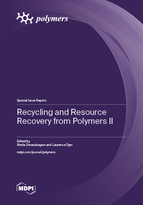Recycling and Resource Recovery from Polymers II
A special issue of Polymers (ISSN 2073-4360). This special issue belongs to the section "Circular and Green Polymer Science".
Deadline for manuscript submissions: closed (10 February 2023) | Viewed by 76439
Special Issue Editors
Interests: energy and emission reductions in process metallurgy, pelletisation, decarbonising cement and iron ore reduction; biomass and waste utilisation in process metallurgy, dewatering, carbon reforming, polymers for carbon reduction; polymers for sustainable materials processing; recycling
Special Issues, Collections and Topics in MDPI journals
Special Issue Information
Dear Colleagues,
Following the success of the Special Issue of Polymers, "Recycling and Resource Recovery from Polymers", we are delighted to reopen this Special Issue, now entitled "Recycling and Resource Recovery from Polymers II".
About 90% of the 300 million tonnes of plastics produced each year is not recycled and disposed of in landfills, posing significant environmental concerns. By 2030, 104 Mt of waste plastics are projected to enter landfill, causing a 50% increase in CO2 emissions from the plastic life cycle and a three-fold CO2 increase caused by plastic incineration due to poor waste management. A zero-waste approach conserves natural resources and reduces pollution from extraction, manufacturing and disposal. The vision for a new circular economy for plastics initiative is supported by three key actions: eliminate, innovate, and circulate. This Special Issue will focus on current and future research concernign the repurposing of plastics at the end of their life for various applications.
Dr. Sheila Devasahayam
Dr. Laurence Dyer
Guest Editors
Manuscript Submission Information
Manuscripts should be submitted online at www.mdpi.com by registering and logging in to this website. Once you are registered, click here to go to the submission form. Manuscripts can be submitted until the deadline. All submissions that pass pre-check are peer-reviewed. Accepted papers will be published continuously in the journal (as soon as accepted) and will be listed together on the special issue website. Research articles, review articles as well as short communications are invited. For planned papers, a title and short abstract (about 100 words) can be sent to the Editorial Office for announcement on this website.
Submitted manuscripts should not have been published previously, nor be under consideration for publication elsewhere (except conference proceedings papers). All manuscripts are thoroughly refereed through a single-blind peer-review process. A guide for authors and other relevant information for submission of manuscripts is available on the Instructions for Authors page. Polymers is an international peer-reviewed open access semimonthly journal published by MDPI.
Please visit the Instructions for Authors page before submitting a manuscript. The Article Processing Charge (APC) for publication in this open access journal is 2700 CHF (Swiss Francs). Submitted papers should be well formatted and use good English. Authors may use MDPI's English editing service prior to publication or during author revisions.
Keywords
- circular economy/plastics economy
- energy recovery
- monomer recovery
- hydrogen energy systems
- emissions reduction
- carbon capture
- carbon conversion reactions
- gasification
- novel cataslysts
- feedstock recycling
- sustainable materials processing (e.g., iron and steel industry)
- polymer wastes in geopolymer concrete (construction, built materials)
- process modelling
- economic analysis








